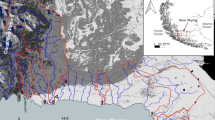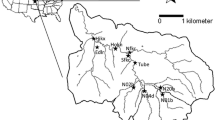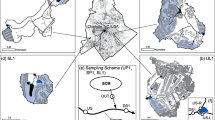Abstract
Dissolved organic carbon (DOC) concentrations and DOC export arestudied during storms to examine the relationship between DOCconcentration and stream discharge and to assess the importance of stormson DOC export. Storms were monitored in seven subcatchments within twosmall watersheds (Harp 4--21 and Harp 3A) on the Precambrian Shield inCentral Ontario, Canada. Stream DOC concentrations increase during stormsby as much as 100% and 410% in Harp3A and Harp 4--21 respectively. The seasonal regression between DOC andstream discharge is significant in subcatchments without wetlands(r2 > 0.7) but is not significant in thetwo subcatchments with small wetland areas (r2 <0.06). On average, regressions based on weekly data yield accurate estimatesof DOC export but the variation in regressions among individual storms andthe small number of high DOC samples result in uncertainties of more than30% in DOC export. The period-weighted calculation ofDOC export from weekly data underestimates export by 14%and 22% in Harp 3A and Harp 4--21 respectively. Stormswere responsible for 57% to 68% of theDOC export in the autumn and 29% to 40%of the DOC export in the spring. A single large storm accounted for31% of the autumn DOC export in Harp 3A. The importanceof individual storms for DOC export and the variation in the relationshipbetween DOC and stream discharge among storms make it difficult to predictthe effects of climate change on DOC export and DOC concentrations.
Similar content being viewed by others
References
Cronan CS (1990) Patterns of organic acid transport from forested watersheds to aquatic ecosystems. In: Perdue EM & Gjessing ET (Eds) Organic acids in aquatic ecosystems (pp 245–260). John Wiley & Sons, NY
Dankevy SN (1989) Groundwater flow and chemistry in a small acid-stressed sub-catchment of the Canadian Shield. Master's Project, University of Waterloo, Ontario (unpublished)
Dann MS, Lynch JA & Corbett ES (1986) Comparison of methods for estimating sulfate export from a forested watershed. J. Environ. Qual. 15 (2): 140–145
Dawson HJ, Ugolini FC, Hrutfiord BF & Zachara J (1978) Role of soluble organics in the soil process of a Podzol, Central Cascades, Washington. Soil Sci. 126: 290–296
Dillon PJ & Molot L (1997) Dissolved organic and inorganic carbon mass balances in central Ontario lakes. Biogeochem. 36: 29–42
Driscoll CT, Fuller RD & Schecher WD (1989) The role of organic acids in the acidification of surface waters in the eastern U.S. Water Air Soil Poll. 43: 21–40
Easthouse KB, Mulder J, Christophersen N & Seip HM (1992) Dissolved organic carbon fractions in soil and stream water during variable hydrological conditions at Birkenes, South Norway. Water Resour. Res. 28 (6): 1585–1596
Eckhardt BW & Moore TR (1990) Controls on dissolved organic carbon concentrations in stream, southern Quebec. Can. J. Fish. Aqu. Sci. 47: 1537–1544
Eshleman KN & Hemond HF (1985) The role of organic acids in the acid-base status of surface waters at Bickford watershed, Massachusetts. Water Resour. Res. 21 (10): 1503–1510
Gates WL, Mitchell JFB, Boer GJ, Cubasch U & Meleshko VP (1992) Climate modelling, climate prediction and model validation. In: Houghton JT, Callander BA & Varney SK (Eds) Climate change 1992. The supplementary report to the IPCC scientific assessment (pp 97–134). Cambridge University Press, UK
Hewlett JD & Hibbert AR (1967) Factors affecting the response of small watersheds to precipitation in humid areas. In: Forest hydrology. Proc. Intern. Symp. on Forest Hydrol., Penn State, August, 1965 (pp 275–290). Pergammon Press, NY
Hinton MJ, Schiff SL & English MC (1993) Physical properties governing groundwater flow in a glacial till catchment. J. Hydrol. 142: 229–249
Hinton MJ, Schiff SL & English MC (1994) Examining the contributions of glacial till water to storm runoff using two-and three-component hydrograph separations. Water Resour. Res. 30 (4): 983–993
Hinton MJ, Schiff SL & English MC (1997) Sources and flowpaths of dissolved organic carbon in two Precambrian Shield catchments. Submitted to Biogeochem.
Hornberger GM, Bencala KE & McKnight DM (1995) Hydrological controls on dissolved organic carbon during snowmelt in the Snake River near Montezuma, Colorado. Biogeochem. 25: 147–165
IPCC (1990) Climate change, the IPCC scientific assessment. Houghton JT, Callander BA & Varney SK (Eds) Cambridge University Press, UK
Jardine PM, Weber NL & McCarthy JF (1989) Mechanisms of dissolved organic carbon adsorption on soil. Soil Sci. Soc. Am. J. 53: 1378–1385
Jeffries DS & Snyder WR (1983) Geology and geochemistry of the Muskoka-Haliburton study area. Data Report DR 83/2, Dorset Research Centre, Dorset, Ontario
Johnson AH (1979) Estimating solute transport in streams from grab samples. Water Resour. Res. 15(5): 1224–1228
Kramer JR, Brassard P, Collins P, Clair TA & Takats P (1990) Variability of organic acids in watersheds. In: Perdue EM & Gjessing ET (Eds) Organic acids in aquatic ecosystems (pp 127–139). John Wiley & Sons, NY
Likens, GE, Bormann H, Pierce RS, Eaton JS & Johnson NM (1977) Biogeochemistry of a forested ecosystem. Springer-Verlag, NY
MacLean RA (1992) The role of the vadose zone in the generation of runoff from a headwater basin in the Canadian Shield. Master's thesis, Wilfrid Laurier University, Waterloo, Ontario
McDowell WH (1985) Kinetics and mechanisms of dissolved organic carbon retention in a headwater stream. Biogeochem 1: 329–352
McDowell WH & Fisher SG (1976) Autumnal processing of dissolved organic matter in a small woodland stream ecosystem. Ecol. 57: 561–569
McDowell WH & Likens GE (1988) Origin, composition, and flux of dissolved organic carbon in the Hubbard Brook Valley. Ecol. Mon. 58(3): 177–195
Meyer JL (1990) Production and utilization of dissolved organic carbon in riverine ecosystems. In: Perdue EM & Gjessing ET (Eds) Organic acids in aquatic ecosystems (pp 281–299). John Wiley & Sons, NY
Meyer JL & Tate CM(1983) The effects of watershed disturbance on dissolved organic carbon dynamics of a stream. Ecol. 64: 33–44
Moore TR (1989) Dynamics of dissolved organic carbon in forested and disturbed catchments, Westland, New Zealand. 1. Maimai. Water Resour. Res. 25: 1321–1330
Mulholland PJ & Watts JA (1982) Transport of organic carbon to the oceans by rivers of North America: a synthesis of existing data. Tellus 34: 176–186
Nelson PN, Baldock JA & Oades JM (1993) Concentrations and composition of dissolved organic carbon in streams in relation to catchment soil properties. Biogeochem. 19: 27–50
Ontario Ministry of the Environment (MOE) (1983) Handbook of analytical methods for environmental samples, Lab. Serv. Branch, Rexdale, Ontario
Schiff SL, Aravena R, Trumbore SE, Hinton MJ, Elgood R & Dillon PJ (1997) Export of DOC from forested catchments on the Precambrian Shield of Central Ontario: Clues from 13C and 14C. Biogeochem. 36: 43–65
Thurman EM (1985) Organic geochemistry of natural waters. Martinus Nijhoff/Dr W. Junk Publishers, Dordrecht
Author information
Authors and Affiliations
Rights and permissions
About this article
Cite this article
Hinton, M., Schiff, S. & English, M. The significance of storms for the concentration and export of dissolved organic carbon from two Precambrian Shield catchments. Biogeochemistry 36, 67–88 (1997). https://doi.org/10.1023/A:1005779711821
Issue Date:
DOI: https://doi.org/10.1023/A:1005779711821




